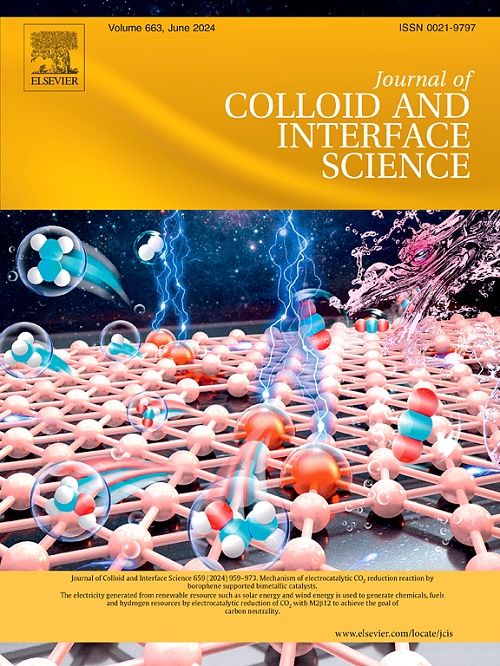Shark skin and mussel-inspired polyurethane hydrogel sponge for wounds with infection and exudate
IF 9.4
1区 化学
Q1 CHEMISTRY, PHYSICAL
引用次数: 0
Abstract
Inspired by the antifouling properties of shark skin and the bioadhesion of mussels, our study presents a three-layer biomimetic wound dressing with hierarchical wettability and rapid exudate drainage capabilities. The shark skin-inspired hydrophobic modified polyurethane (PU) sponge provides antifouling properties and serves as a bacterial barrier. The mussel-inspired dopamine-functionalized carboxymethyl chitosan hydrogel (CMCS-DOP) absorbs exudates and forms an in situ hydrogel, effectively capturing and eliminating bacteria. The porous sponge layer in direct contact with the wound facilitates rapid exudate drainage, preventing excessive wound hydration. This hierarchical structure coordinates exudate transport and bacterial removal. The fabricated PCD hydrogel sponge dressing (PCD dressing) exhibits a wettability transition (contact angle: 3°–35°–101°) and a water vapor transmission rate of 1021–797–691 g/m2. It demonstrates potent bactericidal effects against Staphylococcus aureus and Escherichia coli, with survival rates of only 13 % and 14 %, respectively, and bacterial-blocking efficiencies of 89 % and 94 %. In a chronic bacterial infection wound model, the PCD dressing outperforms conventional clinical dressings, increasing the wound healing rate by 25.8 %, reducing inflammation, and enhancing angiogenesis and collagen deposition. Notably, the PCD mitigates oxidative stress at the wound site by regulating the polarization of anti-inflammatory macrophages. This exudate-draining and responsive dressing offers a promising strategy for promoting the healing of wounds with high exudate levels.

鲨鱼皮和贻贝启发聚氨酯水凝胶海绵伤口感染和渗出
受鲨鱼皮肤的防污特性和贻贝的生物粘附性的启发,我们的研究提出了一种具有分层润湿性和快速渗出液引流能力的三层仿生伤口敷料。鲨鱼皮肤启发的疏水性改性聚氨酯(PU)海绵提供防污性能,并作为细菌屏障。贻贝启发的多巴胺功能化羧甲基壳聚糖水凝胶(CMCS-DOP)吸收渗出液并形成原位水凝胶,有效捕获和消除细菌。与伤口直接接触的多孔海绵层有助于快速渗出液排出,防止伤口过度水化。这种分层结构协调渗出液的运输和细菌的清除。制备的PCD水凝胶海绵敷料(PCD敷料)具有润湿性转变(接触角为3°~ 35°~ 101°),水蒸气透过率为1021 ~ 797 ~ 691 g/m2。它显示出对金黄色葡萄球菌和大肠杆菌的有效杀菌作用,其存活率分别仅为13%和14%,细菌阻断效率为89%和94%。在慢性细菌感染伤口模型中,PCD敷料优于常规临床敷料,使伤口愈合率提高25.8%,减少炎症,促进血管生成和胶原沉积。值得注意的是,PCD通过调节抗炎巨噬细胞的极化来减轻伤口部位的氧化应激。这种渗出液引流和反应性敷料为促进高渗出液水平伤口愈合提供了一种有希望的策略。
本文章由计算机程序翻译,如有差异,请以英文原文为准。
求助全文
约1分钟内获得全文
求助全文
来源期刊
CiteScore
16.10
自引率
7.10%
发文量
2568
审稿时长
2 months
期刊介绍:
The Journal of Colloid and Interface Science publishes original research findings on the fundamental principles of colloid and interface science, as well as innovative applications in various fields. The criteria for publication include impact, quality, novelty, and originality.
Emphasis:
The journal emphasizes fundamental scientific innovation within the following categories:
A.Colloidal Materials and Nanomaterials
B.Soft Colloidal and Self-Assembly Systems
C.Adsorption, Catalysis, and Electrochemistry
D.Interfacial Processes, Capillarity, and Wetting
E.Biomaterials and Nanomedicine
F.Energy Conversion and Storage, and Environmental Technologies

 求助内容:
求助内容: 应助结果提醒方式:
应助结果提醒方式:


